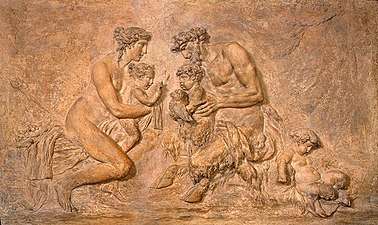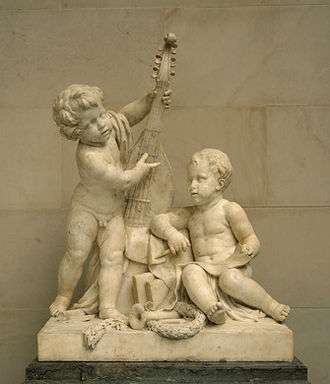Claude Michel
| Claude Michel | |
|---|---|
| Born | December 20, 1738 |
| Died | March 29, 1814 (aged 75) |
| Nationality | French |
| Known for | Sculpting, mainly terracotta |
| Style | Rococo |


Claude Michel (December 20, 1738 – March 29, 1814), known as Clodion, was a French sculptor in the Rococo style, especially noted for his works in terracotta.
Life
He was born in Nancy to Anne Adam and Thomas Michel, an undistinguished sculptor. Anne was the brother of sculptors Lambert-Sigisbert Adam and Francois Gaspard Adam. In Nancy and probably in Lille he spent the earlier years of his life. In 1755 he came to Paris and entered the workshop of his maternal uncle Lambert-Sigisbert Adam, an established sculptor. He remained four years in this workshop, and on his death became a pupil of Jean-Baptiste Pigalle. In 1759 he obtained the grand prize for sculpture at the Académie Royale. In 1761 he obtained the first silver medal for studies from models. In 1762 he went to Rome, where his activity was considerable between 1767 and 1771.
Catherine II of Russia was eager to secure his presence in St Petersburg, but he returned to Paris. Among his patrons, which were very numerous, were the chapter of Rouen, the states of Languedoc, and the Direction generale. His works were frequently exhibited at the Salon. In 1782 he married Catherine Flore, a daughter of the sculptor Augustin Pajou, who subsequently obtained a divorce from him. The agitation caused by the French Revolution drove Clodion in 1792 to Nancy, where he remained until 1798, his energies being spent in the decoration of houses.
Among Clodion's works are a statue of Montesquieu, a Dying Cleopatra, and a chimneypiece at present in the Victoria and Albert Museum, (London). Another known sculpture is called "The Intoxication of Wine."[1] One of his last groups represented Homer as a beggar being driven away by fishermen (1810). Clodion died in Paris, on the eve of the invasion of Paris by the forces of the Sixth Coalition.
Works
Among the public collections holding works by Claude Michel are: the Art Institute of Chicago, the Bowes Museum (County Durham, UK), the Carnegie Museum of Art (Pittsburgh, Pennsylvania), the Cleveland Museum of Art, the Courtauld Institute of Art (London), the Currier Museum of Art (New Hampshire), the Detroit Institute of Arts, the Fine Arts Museums of San Francisco, the Frick Collection (New York City), the Getty Museum (Los Angeles), the Honolulu Museum of Art, the Kimbell Art Museum (Fort Worth, Texas), Kunst Indeks Danmark, the Louvre (Paris), the Metropolitan Museum of Art, Musée Cognacq-Jay (Paris), the Museum of Fine Arts (Boston), Musée des Beaux-Arts (Bordeaux), Museum Boijmans Van Beuningen (Rotterdam), National Museum of Art (Cluj-Napoca), the National Gallery of Armenia, the National Gallery of Art (Washington D.C.), the Norton Simon Museum (Pasadena, California) and the Philadelphia Museum of Art.
See also
References
| Wikimedia Commons has media related to Clodion. |

- ↑
- Clodion's "The Intoxication of Wine" At the Met (NY). Retrieved 29 April 2018.
Further reading
- Parker, James & Le Corbeiller, Clare (1979). A Guide to the Wrightsman Galleries at the Metropolitan Museum of Art. New York: The Metropolitan Museum of Art. ISBN 0-87099-186-8. (see index, Clodion (Claude Michel): p. 127-128)
External links
- Entry and examples at the Metropolitan Museum of Art in New York City
- Bacchante by Clodion.
- Claude Michel in American public collections, on the French Sculpture Census website

- for examples of a Terracotta relief "Satyr and Nymph" at the DMK Collection in Germany